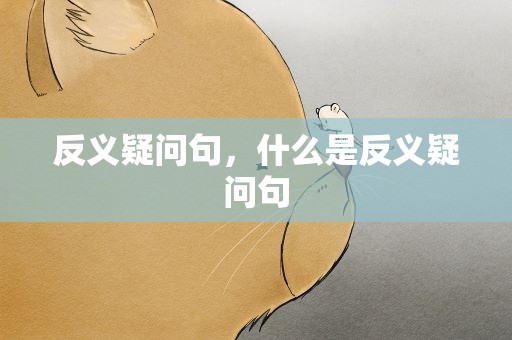反义疑问句有哪些句型
反意疑问句是英语四大问句之一,它是由一个陈述句加上一个短问句而构成的。反意疑问句的基本构成形式是:陈述句+动词(肯定或否定)+主语?如:

①Sheoftenhaslunchatschool,doesn’tshe?②Youdon’tlikesports,doyou?
使用反意疑问句要注意以下若干对应规则:
一、反意疑问句中问句部分的动词与陈述部分的动词在语气上成相反的对应关系,即:
肯定+否定?否定+肯定?如:
①Youcan’tdoit,canyou?②Theyareverylateforthemeeting,aren’tthey?
二、反意疑问句中问句部分的动词与陈述部分的动词种类要对应一致。如:
①Hehassupperathomeeveryday,doesn’the?(不能用hasn’the?)
②Theyhaveknownthematter,haven’tthey?(不能用don’tthey?)
三、反意疑问句中问句部分的动词在时态上应和陈述部分的时态一致。如:
①Theywillgototownsoon,won’tthey?(不能用don’tthey?或aren’tthey?)
②Heworksveryhard,doesn’the?(不能用didn’the?或won’the?)
四、反意疑问句的陈述部分含有由un-,im-,in-,dis-,等否定意义的前缀构成的词语时,陈述部分要视为肯定含义,问句部分用否定形式。如:
①Yourfatherisunhappy,isn’the?(不能用ishe?)
②Themanisdishonest,isn’the?(不能用ishe?)
③ItisimpossibletolearnEnglishwithoutrememberingmorewords,isn’tit?(不能用isit?)
五、反意疑问句的陈述部分带有little,few,never,hardly,seldom等否定意义的词时,问句部分用肯定式。如:
①Shenevertellsalie,doesshe?(不用doesn’tshe?)
②Hewasseldomlate,washe?(不用wasn’the?)
六、反意疑问句的陈述部分为Iam……时,问句部分习惯上用aren’tI?表示。如:
Iamaveryhonestman,aren’tI?
七、反意疑问句的陈述部分为I(We)think(believe,suppose,consider)+that从句时,问句部分的动词及主语与that从句内的动词和主语保持一致。如:
①Ithinkthathehasdonehisbest,hasn’the?
②WethinkthatEnglishisveryuseful,isn’tit?(不用don’twe?)
八、反意疑问句的陈述部分为I(We)don’tthink(believe,suppose,consider)+that从句时,从句为否定意义,问句部分的动词和主语仍与that从句保持一致且用肯定式。如:
①Idon’tthinkthatyoucandoit,canyou?(不用doI?)
②Wedon’tbelievethatthenewsistrue,isit?(不用dowe?)
九、反意疑问句的陈述部分为非第一人称主语+think(believe,suppose,consider)+that从句时,问句部分的动词和主语与陈述部分的主句动词和主语保持一致。如:
①TheyallthinkthatEnglishisveryimportant,don’tthey?(不用isn’tit?)
②Hedidn’tthinkthatthenewswastrue,didhe?(不用wasn’t/wasit?)
十、反意疑问句的陈述部分为主语+said(told,reported,asked……)+that从句时,问句部分的动词和主语与陈述部分的主句动词和主语保持一致。如:
①Theysaidthatyouhadfinishedyourwork,didn’tthey?(不用hadn’tyou)
②Katetoldyouthatshewouldgothere,didn’tshe?(不用wouldn’tshe?)
十一、陈述部分的主语为不定代词something,anything,nothing,everything时,问句部分的主语用it。如:
①Somethingiswrongwiththecomputer,isn’tit?②Nothinghashappenedtothem,hasit?
十二、陈述部分的主语为不定代词somebody(someone),anybody(anyone),nobody(noone),everybody(everyone)时,问句部分的主语用he或they,这时问句动词的数应和he或they一致。如:
①Someonehastakentheseat,hasn’the?
②Everyonehasdonetheirbestinthegame,haven’tthey?
十三、陈述部分为Letme……时,问句部分习惯上用shallI?或willyou?形式。如:
Letmehaveatry,shallI?(willyou?)
十四、陈述部分为Letus……时,问句部分习惯上用willyou?形式。如:
Letusstoptorest,willyou?
十五、陈述部分为Let’s……时,问句部分习惯上用shallwe?形式。如:
Let’sgohometogether,shallwe?
十六、陈述部分用上述情况以外的祈使句时,问句部分一般用willyou?形式表示请求,用won’tyou?形式表示委婉请求或邀请。如:
①Dositdown,won’tyou?/willyou?②Youfeedthebirdtoday,willyou?
③Pleaseopenthewindow,willyou?(won’tyou?)
十七、陈述部分为否定祈使句时,问句部分一般用willyou?形式。如:
Don’tmakeanynoise,willyou?
十八、陈述部分为There(Here)+be+主语时,问句部分用动词+there(here)?形式。如:
①Therearetwocakesontheplate,aren’tthere?②HereisastoryaboutMarkTwain,isn’there?
十九、陈述部分用hadbetter+原形动词表示建议时,问句部分用hadn’t+主语?形式。
①You’dbettertellhimaboutthematter,hadn’tyou?
②Wehadbetterdoitbyourselves,hadn’twe?
二十、陈述部分用usedto+主语时,问句部分用didn’t+主语?或usedn’t+主语?形式。
①Heusedtoliveinthecountry,didn’the?/usedn’the?
②Theyusedtobegoodfriends,didn’tthey?/usedn’tthey?
二十一、陈述部分用must(may,might)+have+V-ed表示推测时,若句中带有明显的过去时间的状语,问句部分动词用过去时形式。如:
①Hemighthaveforgottenhispenintheclassroomyesterday,didn’the?
(不用mightn’the?/hasn’the?)
②Youmusthavegotuplatethismorning,didn’tyou?(不用mustn’tyou?/haven’tyou?)
二十二、陈述部分用must(may,might)+have+V-ed表示推测时,若句中没有带明显的过去时间的状语,问句部分动词用现在完成时形式。如:
①Everyonemusthaveknownthedeathofthewaitress,haven’tthey?(不用mustn’tthey?)
②Youmusthaveworkedthereayearago,didn’tyou?(不用mustn’tyou?/haven’tyou?)
二十三、陈述部分的主语为从句时,问句部分的主语一般用it代替,如:
①Whathesaidistrue,isn'tit?(不用didn’the?)
②Wherewewillbuildthedamhasnotbeendecidedyet,hasit?(不用won’twe?)
二十四、陈述部分的主语为动名词或不定式时,问句的主语用it代替。如:
①Todoonegooddeediseasyforaperson,isn'tit?
②Skatingisyourfavoritesport,isn'tit?
反义疑问句 六大句型都有哪些
如下:
1、祈使句后一般加上willyou或won'tyou构成反意疑问句,用willyou多表示“请求”,用won'tyou多表示提醒对方注意。
2、当陈述部分谓语动词是need,dare,usedto,且这些词被用作实义动词时,其反意疑问句需用do的适当形式。
3、陈述部分主、谓语是Iam…时,反意疑问句用aren'tI或ain'tI,而不是amnotI(可用amInot)。
4、陈述部分的主语是不定代词one时,反意疑问句的主语可以用one,也可用you(美式英语用he)。
5、当陈述部分含Ithink(believe,suppose…)that…结构时,其反意疑问句须与从句的主、谓语保持一致,注意主句的主语必须是第一人称。
6、陈述部分有haveto时,其反意疑问句要用助动词的否定形式。
介绍
反义疑问句即反义附加疑问句。它表示提问人的看法,没有把握,需要对方赞同。附加疑问句由两部分组成:前一部分是一个陈述句,后一部分是一个简短的疑问句,两部分的人称时态应保持一致。
主要形式:陈述部分肯定式+疑问部分否定式;陈述部分否定式+疑问部分肯定式。
什么是反义疑问句
反意疑问句
1.反意疑问句的定义
在陈述句的后面,加上一个简短的问句,对陈述句所叙述的事实或看法提出相反的疑问,这种疑问句叫反意疑问句。在朗读时,陈述句部分用降调,附加的简短问句在表示疑问时用升调,在表示肯定或强调时用降调。
2.反意疑问句的结构
(1)肯定陈述句+否定结构的附加简短问句。Beijingisabeautifulcity,isn'tit?北京是个美丽的城市,不是吗?Youarelatetoday,aren'tyou?今天你迟到了,不是吗?
Sheboughtabagyesterday,didn’tshe?她昨天买了一个书包,不是吗?(2)否定陈述句+肯定结构的附加简短问句
Shedoesn'ttalkmuch,doesshe?她不喜欢说话,是吧?Youcan'tspeakChinese,canyou?你不会说汉语,是吧?
3.反意疑问句中需要注意的问题
(1)附加的简短问句的肯定或否定结构与前面陈述句的肯定或否定相反。It'safineday,isn’tit?天气真好,不是吗?
Birdscan'tswim,canthey?鸟儿不会游泳,是吧?
2)附加简短问句的主语必须和陈述句的主语一致。当陈述句的主语是名词时,附加简短问句的主语必须使用相应的人称代词。
Susanhasanicedoll,doesn'tshe?苏珊有一个漂亮的玩具,不是吗?(she代指Susan)LilyandLucyaren'tsisters,arethey?莉莉和露西不是姐妹,是吧?(they代指LilyandLucy)(3)附加简短问句的时态必须和陈述句的时态保持一致。
Mymotherboughtadressforme,didn’tshe?我妈妈给我买了一件连衣裙,不是吗?Hewon'tbeawayforlong,willhe?他不会离开太久,是吧?(4)附加简短问句如果是否定结构,必须用缩写形式。
It'salongdistanceisn’tit?这是一段很长的距离,不是吗?(isn’t不能写成isnot)Theyarestudents,aren’tthey?他们是学生,不是吗?(arent不能写为arenot)
4.反意疑问句的回答
反意疑问句用yes或no回答。如果陈述句部分叙述的内容是事实,就用yes回答,如果陈述句部分叙述的内容不是事实,就用no回答。需要注意的是,当陈述句部分为否定结构时,答语在译成汉语时有些变化。
It’sraining,isn’tit?下雨了,不是吗?
-Yes,itis./No,itisn’t.是的,下雨了。/不,没下雨。
-It'snotraining,isit?没有下雨,是吧?
-Yes,itis./No,itisn’t.不,下雨了。/是的,没下雨。

